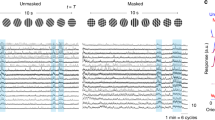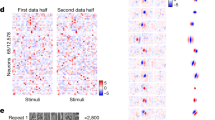Abstract
The existence of two classes of cells, simple and complex, discovered by Hubel and Wiesel in 1962, is one of the fundamental features of cat primary visual cortex. A quantitative measure used to distinguish simple and complex cells is the ratio between modulated and unmodulated components of spike responses to drifting gratings, an index that forms a bimodal distribution. We have found that the modulation ratio, when derived from the subthreshold membrane potential instead of from spike rate, is unimodally distributed, but highly skewed. The distribution of the modulation ratio as derived from spike rate can, in turn, be predicted quantitatively by the nonlinear properties of spike threshold applied to the skewed distribution of the subthreshold modulation ratio. Threshold also increases the spatial segregation of ON and OFF regions of the receptive field, a defining attribute of simple cells. The distinction between simple and complex cells is therefore enhanced by threshold, much like the selectivity for stimulus features such as orientation and direction. In this case, however, a continuous distribution in the spatial organization of synaptic inputs is transformed into two distinct classes of cells.
This is a preview of subscription content, access via your institution
Access options
Subscribe to this journal
Receive 12 print issues and online access
$209.00 per year
only $17.42 per issue
Buy this article
- Purchase on Springer Link
- Instant access to full article PDF
Prices may be subject to local taxes which are calculated during checkout







Similar content being viewed by others
References
Hubel, D.H. & Wiesel, T.N. Receptive fields, binocular interaction and functional architecture in the cat's visual cortex. J. Physiol. (Lond.) 160, 106–154 (1962).
Hubel, D.H. & Wiesel, T.N. Receptive fields and functional architecture of monkey striate cortex. J. Physiol. (Lond.) 195, 215–243 (1968).
Gilbert, C.D. Laminar differences in receptive field properties of cells in cat primary visual cortex. J. Physiol. (Lond.) 268, 391–421 (1977).
Ferster, D. & Lindstrom, S. An intracellular analysis of geniculo-cortical connectivity in area 17 of the cat. J. Physiol. (Lond.) 342, 181–215 (1983).
Hirsch, J.A. et al. Synaptic physiology of the flow of information in the cat's visual cortex in vivo. J. Physiol. (Lond.) 540, 335–350 (2002).
Skottun, B.C. et al. Classifying simple and complex cells on the basis of response modulation. Vision Res. 31, 1079–1086 (1991).
De Valois, R.L., Albrecht, D.G. & Thorell, L.G. Spatial frequency selectivity of cells in macaque visual cortex. Vision Res. 22, 545–559 (1982).
Alonso, J.M., Usrey, W.M. & Reid, R.C. Rules of connectivity between geniculate cells and simple cells in cat primary visual cortex. J. Neurosci. 21, 4002–4015 (2001).
Alonso, J.M. & Martinez, L.M. Functional connectivity between simple cells and complex cells in cat striate cortex. Nat. Neurosci. 1, 395–403 (1998).
Martinez, L.M. & Alonso, J.M. Construction of complex receptive fields in cat primary visual cortex. Neuron 32, 515–525 (2001).
Spitzer, H. & Hochstein, S. Complex-cell receptive field models. Prog. Neurobiol. 31, 285–309 (1988).
Chance, F.S., Nelson, S.B. & Abbott, L.F. Complex cells as cortically amplified simple cells. Nat. Neurosci. 2, 277–282 (1999).
Mechler, F. & Ringach, D.L. On the classification of simple and complex cells. Vision Res. 42, 1017–1033 (2002).
Hansel, D. & van Vreeswijk, C. How noise contributes to contrast invariance of orientation tuning in cat visual cortex. J. Neurosci. 22, 5118–5128 (2002).
Miller, K.D. & Troyer, T.W. Neural noise can explain expansive, power-law nonlinearities in neural response functions. J. Neurophysiol. 87, 653–659 (2002).
Hartigan, J.A. & Hartigan, P.M. The dip test of unimodality. Ann. Stat. 13, 70–84 (1985).
De Valois, R.L. & De Valois, K.K. Spatial vision. Annu. Rev. Psychol. 31, 309–341 (1980).
Movshon, J.A., Thompson, I.D. & Tolhurst, D.J. Receptive field organization of complex cells in the cat's striate cortex. J. Physiol. (Lond.) 283, 79–99 (1978).
Dean, A.F. & Tolhurst, D.J. On the distinctness of simple and complex cells in the visual cortex of the cat. J. Physiol. (Lond.) 344, 305–325 (1983).
Foster, K.H., Gaska, J.P., Nagler, M. & Pollen, D.A. Spatial and temporal frequency selectivity of neurones in visual cortical areas V1 and V2 of the macaque monkey. J. Physiol. (Lond.) 365, 331–363 (1985).
Glezer, V.D., Tsherbach, T.A., Gauselman, V.E. & Bondarko, V.M. Linear and non-linear properties of simple and complex receptive fields in area 17 of the cat visual cortex. A model of the field. Biol. Cybern. 37, 195–208 (1980).
Glezer, V.D., Tsherbach, T.A., Gauselman, V.E. & Bondarko, V.M. Spatio-temporal organization of receptive fields of the cat striate cortex. The receptive fields as the grating filters. Biol. Cybern. 43, 35–49 (1982).
Kagan, I., Gur, M. & Snodderly, D.M. Spatial organization of receptive fields of V1 neurons of alert monkeys: comparison with responses to gratings. J. Neurophysiol. 88, 2557–2574 (2002).
Conway, B.R. & Livingstone, M.S. Space-time maps and two-bar interactions of different classes of direction-selective cells in macaque V-1. J. Neurophysiol. 89, 2726–2742 (2003).
Reid, R.C., Soodak, R.E. & Shapley, R.M. Directional selectivity and spatiotemporal structure of receptive fields of simple cells in cat striate cortex. J. Neurophysiol. 66, 505–529 (1991).
Volgushev, M., Vidyasagar, T.R. & Pei, X. A linear model fails to predict orientation selectivity of cells in the cat visual cortex. J. Physiol. (Lond.) 496, 597–606 (1996).
Lampl, I., Anderson, J.S., Gillespie, D.C. & Ferster, D. Prediction of orientation selectivity from receptive field architecture in simple cells of cat visual cortex. Neuron 30, 263–274 (2001).
Jones, J. & Palmer, L. The two-dimensional structure of simple receptive fields in cat striate cortex. J. Neurophysiol. 58, 1187–1211 (1987).
Bringuier, V., Chavane, F., Glaeser, L. & Fregnac, Y. Horizontal propagation of visual activity in the synaptic integration field of area 17 neurons. Science 283, 695–699 (1999).
Schiller, P.H., Finlay, B.L. & Volman, S.F. Quantitative studies of single-cell properties in monkey striate cortex. I. Spatiotemporal organization of receptive fields. J. Neurophysiol. 39, 1288–1319 (1976).
Carandini, M., Mechler, F., Leonard, C.S. & Movshon, J.A. Spike train encoding by regular-spiking cells of the visual cortex. J. Neurophysiol. 76, 3425–3441 (1996).
Heeger, D.J. Half-squaring in responses of cat striate cells. Vis. Neurosci. 9, 427–443 (1992).
Anderson, J.S., Lampl, I., Gillespie, D.C. & Ferster, D. The contribution of noise to contrast invariance of orientation tuning in cat visual cortex. Science 290, 1968–1972 (2000).
Hodgkin, A.L. & Huxley, A.F. A quantitative description of membrane current and its application to conduction and excitation in nerve. J. Physiol. (Lond.) 117, 500–544 (1952).
Azouz, R. & Gray, C.M. Dynamic spike threshold reveals a mechanism for synaptic coincidence detection in cortical neurons in vivo. Proc. Natl. Acad. Sci. USA 97, 8110–8115 (2000).
Heggelund, P. Quantitative studies of the discharge fields of single cells in cat striate cortex. J. Physiol. (Lond.) 373, 277–292 (1986).
Mata, M.L. & Ringach, D.L. Spatial overlap of 'on' and 'off' subregions and its relation to response modulation ratio in macaque primary visual cortex. J. Neurophysiol. (in the press).
Carandini, M. & Ferster, D. Membrane potential and firing rate in cat primary visual cortex. J. Neurosci. 20, 470–484 (2000).
Jagadeesh, B., Wheat, H.S., Kontsevich, L.L., Tyler, C.W. & Ferster, D. Direction selectivity of synaptic potentials in simple cells of the cat visual cortex. J. Neurophysiol. 78, 2772–2789 (1997).
Tao, L., Shelley, M., McLaughlin, D. & Shapley, R. An egalitarian network model for the emergence of simple and complex cells in visual cortex. Proc. Natl. Acad. Sci. USA 101, 366–371 (2004).
Hirsch, J.A., Alonso, J.M., Reid, R.C. & Martinez, L.M. Synaptic integration in striate cortical simple cells. J. Neurosci. 18, 9517–9528 (1998).
Gilbert, C.D. Microcircuitry of the visual cortex. Annu. Rev. Neurosci. 6, 217–247 (1983).
Chung, S. & Ferster, D. Strength and orientation tuning of the thalamic input to simple cells revealed by electrically evoked cortical suppression. Neuron 20, 1177–1189 (1998).
Brainard, D.H. The Psychophysics Toolbox. Spat. Vis. 10, 433–436 (1997).
Pelli, D.G. The VideoToolbox software for visual psychophysics: transforming numbers into movies. Spat. Vis. 10, 437–442 (1997).
Sokal, R.R. & Rohlf, F.J. Biometry: The Principles and Practice of Statistics in Biological Research (W.H. Freeman, New York, 1995).
Acknowledgements
We thank D.L. Ringach, J.D. Victor and K.D. Miller for comments on the manuscript. I. Lampl, D.C. Gillespie and J.S. Anderson participated in data collection. This work was supported by grants from the National Institutes of Health, the National Science Foundation and the Human Frontier Science Program.
Author information
Authors and Affiliations
Corresponding author
Ethics declarations
Competing interests
The authors declare no competing financial interests.
Supplementary information
Rights and permissions
About this article
Cite this article
Priebe, N., Mechler, F., Carandini, M. et al. The contribution of spike threshold to the dichotomy of cortical simple and complex cells. Nat Neurosci 7, 1113–1122 (2004). https://doi.org/10.1038/nn1310
Received:
Accepted:
Published:
Issue Date:
DOI: https://doi.org/10.1038/nn1310
This article is cited by
-
E-I balance emerges naturally from continuous Hebbian learning in autonomous neural networks
Scientific Reports (2018)
-
Empiricism without magic: transformational abstraction in deep convolutional neural networks
Synthese (2018)
-
More than meets the eye
Nature Neuroscience (2016)
-
Functional implications of orientation maps in primary visual cortex
Nature Communications (2016)
-
Orientation selectivity in cat primary visual cortex: local and global measurement
Neuroscience Bulletin (2015)



